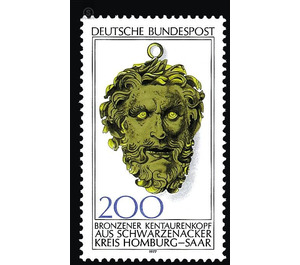Archaeological Heritage (2) - Germany / Federal Republic of Germany 1977 - 200 Pfennig
Theme: Art & Culture
| Country | Germany / Federal Republic of Germany |
| Issue Date | 1977 |
| Face Value | 200.00 |
| Color | brown white |
| Perforation | K 14 |
| Printing Type | Multicolor offset printing |
| Stamp Type | Postage stamp |
| Item Type | Stamp |
| Chronological Issue Number | 834 |
| Chronological Chapter | GER-BRD |
| SID | 854278 |
| In 30 Wishlists | |
The bronze centaur head is one of the most important examples of small Roman sculpture in Germany. He comes from a Roman settlement in Schwarzenacker in today's Homburg-Saar and was found in the last century. With a height of 14 cm and a width of almost 11 cm, the head originally belonged to a larger statue. The animal's ears characterize him as the head of a centaur, that man-horse hybrid of Greek mythology. The head is cast in bronze hollow, the eyes are designed with silver. With silver plate and the rows of teeth are covered, which are visible in the half-open mouth. The ears are pointed forward, the taut, rough face is framed by the shaggy hair and beard, which gives the whole head a very lively, wild look. Today one tends to regard the centaur head as a Roman copy of a Hellenistic model, which dates back to the second half of the 1st century BC. Chr. Shown is a silver bowl depicting the goddess Athena from the Hildesheim treasure trove.


